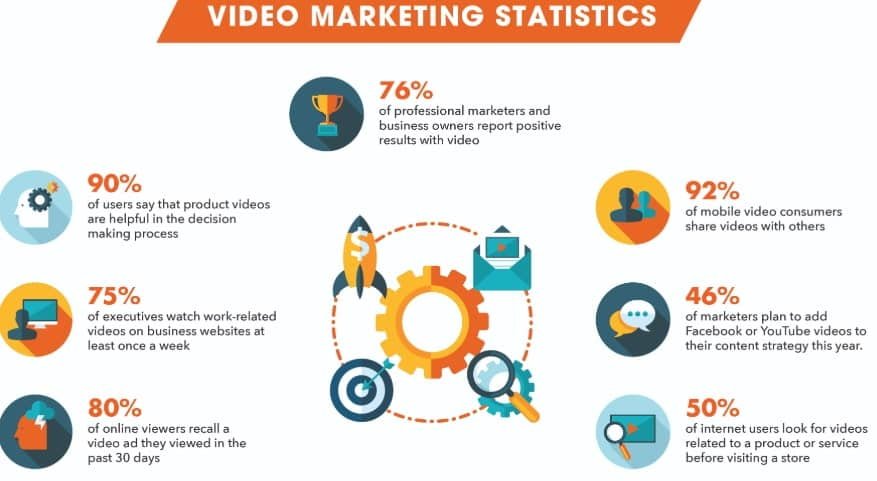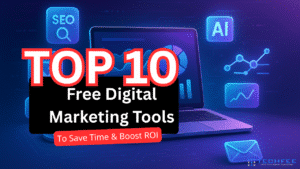Video marketing trends are rapidly reshaping how brands connect with their audiences, and from 2025 is set to bring even more groundbreaking changes.
From interactive content to personalized video experiences, staying on top of these trends is crucial for staying competitive.
Video marketing took off in 2023 in ways that not many people could have imagined. Brands that used it got more engagement from their customers than ever before.
When we get to 2026, though, the game changes even more quickly. As you scroll through your social feed, you see a lot of short, flashy videos, live streams that appear at random, and interactive videos that let you pick your own journey.
But there is a catch: people who don’t change with the times will be left behind and drown in a sea of old material.
To stay ahead, you need to know about the newest trends—those that will not only get people’s attention but also turn them into loyal customers.
According to Vidico, 87% of marketers attribute an increase in lead generation to their use of video content, and 87% claim video has directly increased sales.
So, this post is your complete guide to the 12 video marketing trends that will change everything in 2026.
There are a lot of trends that will affect your business in the future.
These include the rise of AI-powered personalized content, AR and VR’s immersive potential, and shoppable videos’ growing impact.
Are you ready to dive in and make sure your plan will work in the future?
Let’s discuss how you can be the best at video marketing in 2026.
Explosive Video Marketing Trends to Supercharge Your Brand

1. Rise of Interactive Video Content
Interactive video content is transforming how audiences engage with brands, making passive watching a thing of the past.
Engagement through interactivity brings numerous benefits. It allows viewers to participate actively by choosing outcomes, answering questions, or clicking through product details, leading to deeper engagement and higher retention rates.
For example, brands like Netflix have experimented with “choose your own adventure” formats, and e-commerce brands have incorporated clickable hotspots within videos to showcase products.
These features keep users engaged longer and create memorable experiences that traditional videos simply can’t match.
The technology behind interactive videos has also evolved, making it more accessible than ever for marketers.
Tools like Wirewax, Rapt Media, and Vudoo offer user-friendly platforms that enable brands to create immersive, interactive experiences without extensive technical knowledge.
These platforms allow for seamless integration of quizzes, polls, branching narratives, and even shoppable elements within videos, offering a dynamic way to interact with the audience.
Several brands have successfully leveraged interactivity to stand out in a crowded digital space.
Take, for instance, the beauty brand Sephora, which uses interactive video tutorials where users can click on specific products to learn more or add them to their cart.
Another example is Honda’s “The Other Side“ campaign, which let viewers switch between two parallel storylines with the press of a button, providing an immersive, engaging experience.
These case studies showcase how interactivity enhances user experience and drives engagement and conversions, proving it’s a must-have strategy for video marketing in 2026.
2. Enhanced Personalization Techniques
In 2026, personalized video content will become more sophisticated, tailoring each viewer’s experience to their unique preferences and behaviors.
Tailoring content to audience segments involves creating specific videos for different customer personas, which increases relevance and engagement.
Strategies like segmenting audiences based on demographics, buying history, or behavior allow marketers to deliver videos that speak directly to the needs and interests of each group.
Tools such as HubSpot and Vidyard help brands easily manage and deliver personalized content to segmented audiences, ensuring that the right message reaches the right people.
AI and machine learning are playing a crucial role in advancing video personalization.
By analyzing vast amounts of data, AI can predict what content viewers want to see, enabling brands to deliver hyper-personalized videos at scale.
Machine learning algorithms constantly refine these predictions, ensuring that each piece of content becomes increasingly relevant over time.
For example, AI can analyze viewer behavior, such as which products they’ve clicked on or how long they’ve watched a certain video, to recommend similar or complementary content.
Several real-life examples showcase the power of personalization in video marketing.
Spotify, for instance, uses AI to create personalized video playlists based on users’ listening habits, delivering a tailored experience that keeps users engaged.
Another great example is Nike, which sends personalized videos to customers showing their workout progress based on data collected from their Nike+ app.
These success stories demonstrate how brands are using personalization to build stronger connections with their audiences, leading to increased loyalty and conversions.
3. Short-Form Video Dominance
Short-form video content has taken the digital world by storm, and its popularity shows no signs of slowing down in 2026.
The popularity of short-form content is driven by the changing consumption habits of audiences, who prefer quick, digestible videos that get straight to the point.
According to recent statistics, videos under 60 seconds have some of the highest engagement rates, with TikTok videos alone receiving billions of views daily.
A study by HubSpot revealed that 73% of consumers prefer to watch a short video to learn about a product or service, making this format crucial for marketers looking to capture attention in a matter of seconds.
Platforms leading the charge in short-form video are TikTok, Instagram Reels, and YouTube Shorts.
TikTok has been the pioneer in this space, with its algorithm designed to surface viral content based on user interests and behavior.
Instagram quickly followed suit with Reels, offering brands a way to reach new audiences through engaging, short clips that integrate seamlessly with the platform’s interface.
YouTube Shorts, with its vast existing user base, is becoming a strong competitor, allowing creators and brands to repurpose their long-form content into bite-sized versions that can reach a wider audience.
Creating compelling short videos requires a different approach than longer content. The key is to capture attention within the first few seconds, using eye-catching visuals, bold captions, or hooks that immediately draw viewers in.
Best practices include:
- Keeping the content concise.
- Focusing on one clear message or call to action.
- Ensuring high-quality production even in short formats.
Additionally, adding music, trending effects, and strong storytelling can help increase the shareability of your videos. Brands that master these techniques will continue to dominate in the short-form video landscape of 2026.
Unlock the full potential of AI for your business
4. The Growth of Live Streaming
Live streaming has become a powerhouse in video marketing, and its growth continues to thrive in 2026.
Why live streaming is thriving boils down to its ability to create real-time engagement, authenticity, and immediacy that pre-recorded content often lacks.
Audiences love the sense of connection live streams bring, as they can interact with brands and influencers directly, ask questions, and get instant responses.
According to a recent study, 80% of consumers prefer watching live videos from a brand over reading a blog, and live streaming can generate up to six times more interactions than traditional video content.
This trend is further fueled by platforms like Facebook, Instagram, and Twitch, which have made live streaming more accessible than ever.
Effective live streaming strategies require careful planning and execution to maximize engagement.
Brands should start by selecting the right platform that suits their audience, whether it’s Instagram Live for casual, mobile-friendly streams or YouTube Live for longer, more professional broadcasts.
Planning is key, and marketers should create an outline of the event, promote it in advance, and ensure technical setups like lighting and sound are optimized for a smooth experience.
Engaging with viewers in real-time is crucial; responding to comments, running polls, or doing live giveaways keeps the audience actively involved.
Having a dedicated moderator can also help manage questions and interactions to ensure everything runs smoothly.
Several examples of successful live campaigns demonstrate the power of this format. For instance, brands like Adidas have used live streaming to unveil new products, creating buzz and driving immediate sales.
Another standout example is the live-streaming success of Tarte Cosmetics, which regularly hosts makeup tutorials and Q&A sessions, generating high levels of engagement from their loyal fan base.
These brands illustrate how live streaming can drive real-time interaction, boost brand loyalty, and create immediate opportunities for conversions.
5. Integration of Augmented Reality (AR) and Virtual Reality (VR)
The integration of Augmented Reality (AR) and Virtual Reality (VR) in video marketing is revolutionizing how brands engage with consumers.
AR and VR provide immersive, interactive experiences that go beyond traditional video formats, allowing viewers to interact with products or environments in ways never before possible.
In 2026, brands are increasingly using AR to overlay digital elements into real-world settings, while VR transports users into entirely virtual environments.
These technologies are becoming more accessible with the rise of devices like smartphones, AR glasses, and VR headsets, making them a powerful tool for marketers seeking to enhance engagement.
Use cases and applications of AR and VR are transforming the customer experience across various industries.
For example, in retail, brands like IKEA are using AR to let customers visualize furniture in their own homes before purchasing.
Beauty brands such as L’Oréal have implemented AR try-on features, allowing customers to see how makeup products will look on their faces through their phones.
VR has also found significant applications, with automotive companies like Volvo offering virtual test drives, and tourism brands like Marriott creating virtual travel experiences to showcase destinations.
These applications not only engage customers but also build confidence in purchasing decisions, leading to higher conversions.
Looking at the future prospects, AR and VR are expected to continue evolving, with more seamless integration into everyday marketing strategies.
As technology advances, AR and VR are predicted to become more user-friendly and accessible through wearable tech and improved mobile capabilities.
Future developments may include more personalized AR and VR experiences, where users can interact with highly customized content based on their preferences and data.
The line between physical and digital experiences will blur even further, giving brands endless opportunities to create captivating, immersive experiences that set them apart in the competitive video marketing landscape of 2026 and beyond.
6. Focus on Authenticity and User-Generated Content

In 2026, video marketing will increasingly emphasize the power of authenticity, as consumers are drawn to content that feels genuine and relatable.
Audiences have grown tired of overly polished, scripted videos and are craving real, unfiltered experiences that build trust with brands.
Authenticity matters because it humanizes brands and fosters deeper connections with viewers.
Studies show that 86% of consumers value authenticity in brand communication, and videos that reflect real emotions, behind-the-scenes moments, and honest storytelling are more likely to resonate with audiences, boosting engagement and loyalty.
Leveraging user-generated content (UGC) is one of the most effective ways to capitalize on this trend. UGC is content created by consumers, such as reviews, testimonials, and social media posts, which brands can incorporate into their video marketing strategy.
To encourage UGC, brands can run campaigns that ask customers to share their experiences with a product or service, offer incentives like giveaways or discounts, and create branded hashtags to make it easy for users to participate.
Once collected, UGC can be utilized in promotional videos, product showcases, and even as testimonials in ads. Not only does UGC increase trust, but it also provides social proof, making potential customers more confident in their buying decisions.
Several brands are doing it right when it comes to authenticity and UGC.
For instance, GoPro built its entire marketing strategy around user-generated content, showcasing videos filmed by customers using their products in extreme environments.
This approach has not only boosted sales but also created a loyal community of content creators.
Another great example is Coca-Cola’s “Share a Coke“ campaign, which invited consumers to share photos and videos of themselves with personalized Coke bottles.
These case studies highlight how embracing authenticity and UGC can amplify brand reach and foster a deeper connection with audiences.
7. Advanced Video Analytics and Insights
As video marketing continues to evolve, advanced video analytics and insights are becoming crucial for crafting data-driven strategies.
The importance of data-driven decisions lies in their ability to provide actionable insights that inform marketing tactics and improve ROI.
By leveraging tools like Google Analytics, Vidooly, and Wistia, brands can gain a deeper understanding of how their videos are performing, which allows them to optimize content and strategies based on real-time data.
These insights help marketers make informed decisions, tailor their approaches to better meet audience needs, and allocate resources more effectively.
Key metrics to track are essential for evaluating the success of video content. Engagement metrics, such as likes, shares, comments, and watch time, reveal how well viewers are interacting with the content.
Retention rates show how long viewers stay engaged with the video, indicating the quality and relevance of the content.
Conversion rates track how many viewers take desired actions, such as signing up for a newsletter or making a purchase, providing a direct measure of the video’s impact on business goals.
Monitoring these metrics helps identify what works and what doesn’t, allowing for more precise adjustments.
Utilizing analytics for optimization involves several practical tips to enhance video performance.
Start by analyzing which segments of your videos have the highest engagement and retention rates, and use this data to adjust content length, format, or delivery.
Experiment with A/B testing to compare different video versions and determine which resonates better with your audience.
Additionally, leveraging heatmaps and viewer behavior data can highlight areas where viewers drop off, allowing you to refine your content to keep viewers engaged.
Regularly reviewing and acting on these insights ensures that your video marketing efforts are continually evolving and improving, helping you stay ahead in the competitive landscape of 2026.
8. Enhanced Video SEO Strategies
In 2026, enhanced video SEO strategies are essential for ensuring that video content reaches its target audience and achieves maximum visibility.
Why video SEO is crucial stems from its ability to improve search engine rankings, drive more organic traffic, and increase engagement.
Videos that are optimized for search engines are more likely to appear in search results, attract more views, and convert viewers into customers.
Effective video SEO helps your content stand out in a crowded digital landscape, making it easier for potential customers to discover and engage with your brand.
Optimizing video titles, descriptions, and tags is a fundamental aspect of video SEO. Titles should be clear, concise, and include relevant keywords that accurately reflect the content of the video.
Descriptions should provide a detailed overview of the video’s content, incorporating primary and secondary keywords to improve searchability.
Tags help categorize the video and make it easier for search engines to understand its context. Using a mix of broad and specific tags can help the video reach a wider audience while also targeting niche interests.
Additionally, creating compelling thumbnails and including a call-to-action in your titles and descriptions can further boost click-through rates and viewer engagement.
Leveraging transcriptions and captions significantly enhances video SEO by providing additional text for search engines to index.
Transcriptions of spoken content help search engines understand the context and relevance of the video, improving its chances of ranking higher in search results.
Captions not only make videos more accessible to a broader audience, including those with hearing impairments, but they also contribute to better engagement and retention.
Both transcriptions and captions should be accurate and well-timed to ensure that they align with the video content and provide a seamless viewing experience.
By integrating these elements, you can improve the searchability of your videos, enhance user experience, and drive more organic traffic to your content.
9. Incorporation of Shoppable Videos
The incorporation of shoppable videos represents a significant leap forward in video marketing, blending content with commerce in a seamless and engaging way.
What are shoppable videos? These are interactive videos that allow viewers to make purchases directly from the video content.
By integrating clickable product links, interactive elements, or in-video shopping carts, shoppable videos enable viewers to explore and buy products without leaving the video experience.
The benefits of shoppable videos are substantial: they streamline the purchase process, reduce friction, and increase conversion rates by capitalizing on the viewer’s immediate interest in the product.
According to recent studies, shoppable videos can boost conversion rates by up to 30%, making them a powerful tool for driving sales.
Implementing shoppable features involves selecting the right platforms and tools to integrate these functionalities into your video content.
Platforms like Instagram and TikTok have built-in features that allow creators to tag products directly in their videos.
Tools such as Shopify’s Video Commerce and Adludio also enable the creation of shoppable video experiences by linking products within the video player.
To successfully implement these features, brands should ensure their product catalogs are well-organized, create compelling video content that highlights the products effectively, and test various interactive elements to determine what resonates best with their audience.
Successful examples of brands boosting sales with shoppable videos illustrate the effectiveness of this trend.
For instance, fashion retailer ASOS has used shoppable videos to showcase outfits and allow viewers to click on items for immediate purchase, leading to increased sales and customer engagement.
Another example is the beauty brand Sephora, which utilizes shoppable videos to demonstrate makeup techniques and link directly to the featured products, resulting in a more interactive and personalized shopping experience.
These case studies demonstrate how shoppable videos can enhance the customer journey, drive conversions, and provide a more immersive shopping experience, making them a key trend to watch in 2026.
10. Cross-Platform Video Marketing
In 2026, cross-platform video marketing is becoming increasingly vital for brands aiming to reach a diverse audience across multiple digital touchpoints.
A unified strategy is important because of its ability to create a cohesive brand experience and maximize the impact of video content.
A unified approach ensures that messaging remains consistent across various platforms while leveraging each platform’s unique strengths.
Benefits include increased brand recognition, enhanced audience engagement, and improved campaign performance.
By integrating video content seamlessly across platforms such as YouTube, Facebook, Instagram, and LinkedIn, brands can drive more comprehensive and effective marketing efforts.
Adapting content for different platforms is crucial for optimizing video performance. Each platform has its own best practices and audience preferences.
For example, Instagram and TikTok favor short, attention-grabbing videos with engaging visuals, while YouTube is suited for longer, more detailed content.
Tailoring videos to fit platform-specific requirements, such as aspect ratios, video lengths, and interactive features, can significantly enhance viewer engagement.
Additionally, utilizing platform analytics to understand audience behavior and preferences allows for more precise content adjustments. Ensuring that each video is optimized for the platform it’s on, while maintaining a consistent brand voice, can lead to more effective cross-platform marketing.
Case studies of brands excelling in cross-platform marketing provide valuable insights into successful strategies.
For instance, Red Bull has mastered cross-platform video marketing by producing high-energy content tailored to each platform. Their YouTube channel features long-form extreme sports videos, while their Instagram and TikTok accounts showcase shorter, visually captivating clips.
Similarly, Nike effectively uses cross-platform video marketing by aligning their content strategy with each platform’s strengths, such as motivational ads on YouTube and interactive challenges on Instagram.
These examples illustrate how a strategic approach to cross-platform video marketing can enhance brand visibility, engage a broader audience, and drive significant results across different digital channels.
11. Emphasis on Mobile-First Video Content
In the mobile-first era, video marketing must adapt to the dominance of mobile devices, which now account for over 70% of global video views.
With users dedicating a significant portion of their online time to smartphones and tablets, a mobile-first approach is essential for capturing and retaining attention.
This trend underscores the necessity for brands to design video content that aligns with the mobile viewing experience and meets the expectations of a mobile-centric audience.
Designing for mobile involves implementing best practices to ensure videos are engaging and optimized for smaller screens.
Using vertical or square video formats can enhance visibility and user experience on mobile devices, while ensuring that text and visuals are clear and legible is crucial.
Videos should be brief and captivating, delivering key information early to align with shorter attention spans.
Additionally, incorporating mobile-friendly features like captions and interactive elements can boost engagement and accessibility.
Rigorous testing across various mobile devices and screen sizes is essential to provide a seamless and high-quality viewing experience.
Examples of effective mobile video campaigns highlight the success of mobile-first strategies.
The beauty brand Glossier, for example, excels with short, visually compelling videos tailored for Instagram Stories and TikTok.
Optimized for vertical viewing, these videos include direct calls-to-action that enhance engagement.
Similarly, Spotify’s “Wrapped“ campaign features personalized, mobile-optimized year-in-review videos that are easily shareable and viewable on smartphones.
These examples demonstrate how a focus on mobile-first video content can improve user experience, drive higher engagement, and deliver impressive results in the mobile-centric digital landscape of 2026.
12. Utilizing Video for Customer Support and Engagement
The role of video in customer support has evolved into a crucial component for enhancing user experience and engagement.
Videos offer a dynamic and interactive way to address customer queries and issues, providing visual explanations and step-by-step guides that text alone may not fully convey.
The benefits of integrating video into customer support include faster resolution times, reduced support tickets, and improved customer satisfaction.
By leveraging video, brands can create a more personalized and effective support experience, making complex processes easier to understand and more accessible.
Creating support videos involves several strategies to ensure clear and effective communication. Start by identifying common customer issues and frequently asked questions, then develop videos that address these topics directly.
It’s important to use a clear and engaging style, incorporating visual aids and demonstrations to enhance understanding.
Keeping videos concise and focused helps maintain viewer interest, while including call-to-action elements, such as links to additional resources or contact options, can provide further assistance.
Additionally, ensuring that videos are easily accessible through your website, help center, or customer support channels is key to maximizing their effectiveness.
Engagement through educational content is another powerful way to utilize video for customer support.
Providing educational videos that offer valuable insights or tutorials can address common questions and empower customers to use products or services more effectively.
For example, tech companies often create how-to videos that cover troubleshooting tips or feature demonstrations, enhancing customer knowledge and reducing the need for direct support.
Brands like HubSpot and Adobe excel in this area by offering extensive libraries of educational videos that cater to different aspects of their products.
By focusing on high-quality, informative content, brands can engage their audience, build trust, and foster a positive customer relationship.
Get Voisi With All Upgrades & Add-Ons With A Super Discount & One-Time Deal
Conclusion: Video Marketing Trends
As we look at how video marketing is changing quickly in 2026, it’s clear that keeping ahead of the curve is key to success.
How brands connect with their audiences is changing because of the popularity of short-form videos, the rise of interactive video content, and better ways to personalize content.
The popularity of live streaming, the combination of AR and VR, and the focus on authenticity and user-generated content show how important it is to make relationships that are real and immersive.
At the same time, improved video analytics, better video SEO, and the addition of shoppable videos make it even more important to use data-driven strategies and make shopping easy.
Cross-platform marketing and a mobile-first approach are important for reaching viewers wherever they are. Using video for customer service and engagement shows how visual material can improve interactions with customers.
Brands that want to do well in the competitive world of video marketing need to not only follow these trends, they need to do so.
If you follow these game-changing trends, your video marketing will not only get more people to watch and interact with it, but it will also lead to new ideas and more growth.
We hope that this guide has helped you think of ways to sell your videos more effectively. If you liked this post, you might want to sign up for our email list to get the latest news and trends.
Feel free to leave a comment below if you have any questions or thoughts.
Also, share this post with other people who might find it useful. Please get in touch with us!
FAQs: Video Marketing Trends
What Are the Most Important Video Marketing Trends for 2024?
The most important video marketing trends for 2024 are short-form content, live streaming, interactive videos, personalized video experiences, AI-generated content, and shoppable videos.
How Can I Implement Interactive Videos in My Marketing Strategy?
Implementing Interactive Videos: Use tools like Wistia or Wirewax to add clickable hotspots, quizzes, or polls within your videos to engage viewers and gather data.
What Tools Are Best for Creating Personalized Video Content?
Best Tools for Personalized Video Content: Tools like Vidyard, Bonjoro, and Loom enable the creation of customized video content based on user data or preferences.
How Do I Optimize My Videos for Better Search Rankings?
Optimizing Videos for Better Search Rankings:
- Use relevant keywords in titles, descriptions, and tags.
- Create engaging thumbnails.
- Ensure mobile-friendliness, and include captions for SEO.
What Are Shoppable Videos and How Can They Benefit My Business?
Shoppable Videos Benefits: Shoppable videos allow viewers to click on products directly within the video, enhancing user engagement and driving direct sales.










